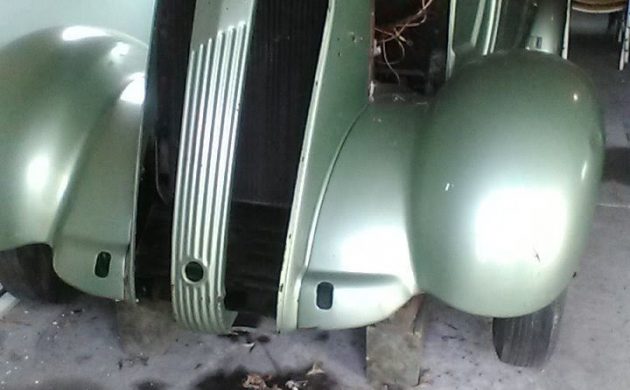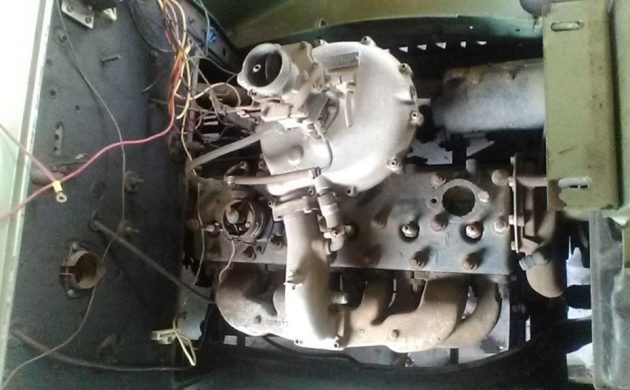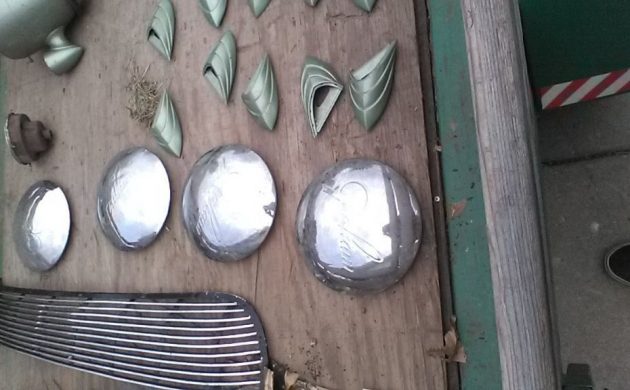50% Restored: 1937 Graham Supercharged Sedan
For me, the supercharged Graham sedan is what I envision as the perfect moonshine runner’s vehicle. It’s got the imposing looks, good speed and plenty of room for storing some white lightning where the constable won’t find it. This project-grade example may not have done anything illegal back in the day, but it deserves having its stalled restoration completed just the same. Find it here on eBay with an opening bid of $6K and no action as of yet.
There’s no reserve, either, so it could be worth a closer look. Clearly, some work has been done but it seems based on the seller’s description that some of it has unraveled over time. The body has dings and scratches from storage and the seller goes so far as to say it should be repainted. The interior was previously restored with the correct mohair panels but some of the doors will need to be redone. The seller notes, however, the Graham is quite solid and there is no body filler to be found anywhere on the car.
Engine-wise, the seller says it is original to the car with the supercharger still attached. Graham’s innovative use of the supercharger gave the company significant notoriety, using it on both eight- and six-cylinder cars and producing the most vehicles with a supercharger attached until Buick outpaced them in the 1990s. An in-house design, the supercharger is one of the more intriguing aspects of restoring a car like this, if only to hear the trademark whine in a vintage American sedan.
The eBay gallery photos show much of the missing trim and other small pieces not currently attached to the body. The seller says the Graham is entering a phase of just needing final assembly performed, which depends on whether you want to repaint the entire body. With the correct whitewall tires and steel wheels and hubcaps mounted, these big-body sedans enjoy a commanding presence on the road, and this example is too close to completion to ignore if you’ve been hunting for a true pre-war classic.
Auctions Ending Soon
 2006 Ford Mustang Saleen S281 SCBid Now5 hours$16,000
2006 Ford Mustang Saleen S281 SCBid Now5 hours$16,000
 2002 Subaru Impreza WRXBid Now3 days$333
2002 Subaru Impreza WRXBid Now3 days$333
 1975 Chevrolet Corvette ConvertibleBid Now3 days$3,000
1975 Chevrolet Corvette ConvertibleBid Now3 days$3,000
 1964 Ford F-100 Camper CustomBid Now3 days$2,000
1964 Ford F-100 Camper CustomBid Now3 days$2,000
 2006 Jeep Wrangler SportBid Now5 days$10,500
2006 Jeep Wrangler SportBid Now5 days$10,500





Comments
What a lovely thing!
My idea of the perfect hobby for starting my retirement! I’ve always liked restored Grahams.
Well, IDK about a “rum runner”, they used 1940 Ford business coupes with 3 deuce V8’s with overdrive for a reason. Leave this old jalopy ( supercharged or not) in the dust. Matter of fact, I bet there were cops that used these( in Indiana) and watched those Ford tail lights disappear. When we hear the word “supercharged”, images of flame belching fuel cars comes to mind, but I think these were anything but.
50% restored means only 90% more to go before it’s finished!
… and then 10% left undone.
I would prefer having this as a retirement project than any 40’s Ford, they are been there done that projects. It seems they are like a**holes, everyone has one. I want something that is not around every corner or has a blower sticking out of the hood. I certainly have done enough of them to last a lifetime.
I would have to say I dont think thats a supercharger but a turbocharger instead as it is driven from exhaust gases
It is a supercharger but a different type. It is basically a big fan and not the lobed gear style of the Rootes type you see everywhere. My reading indicates the Graham fan type supercharger has similar characteristics to a turbocharger in that it has to rev higher to get the boost whereas the lobe type gets boost low down because there is, in theory, no clearance around the lobe hence it becomes a positive displacement pump. If there was a photo of the opposite side of the engine you would see a drive shaft up to the fan and a 90 degree gearbox with another shaft taking the drive off the front of the engine somewhere. I don’t know if there was a clutch in there as well which engages at higher revs or on demand because at low revs you would be using energy to spin the fan with little or no boost produced.
I think the same type of supercharger was used on the Cord and other cars.
No, it is driven by gears – probably reverse worm – from the camshaft. What looks kinda like feed from the exhaust manifold is actually the feed into the intake. The carburetor is a one-barrel on top of the centrifugal blower housing – you can just make that out in the photo. This is the same kind of system used on the Auburn/Cord/Duesenberg cars.
It isn’t a terribly efficient setup; on the Cords it was good for a claimed 25hp boost. The reverse-worm eats a lot of spare energy, and packing fuel-air mixture into a flathead engine is a poor substitute for going to overhead valves. The case for Graham’s going to supercharging was most likely economic: it didn’t cost them as much as an engine redesign but gave them some extra sales traction … for a while.
Thanks Will. I thought I had seen a system on a car using the same type of supercharger that took its drive from the front of the engine, however, taking it straight off the camshaft similar to a distributor would work also but it must be quite a large gear to transmit the power to drive the fan. I can imagine having to buy gears and/or a camshaft every so often as I have seen stripped distributor gears as well.
Can you direct me to an internet site that might have some detail on the supercharger type with some photos or an exploded diagram?
Also, if you want to read about another interesting supercharger type Google, Comprex Pressure Wave Supercharger.
Its a supercharger. There are a pair of v belts that run off the the crankshaft down inside the engine compartment on the drivers side of the that you can’t se unless your looking for them. I know this because my former high school shop teacher has a rumble seat coupe that’s been fully restored.
I don’t know but all I see is the intake connection. I do not believe that turbochargers were implemented on anything but aircraft at that time. May be wrong. In fact the first turbocharger in a car was a GM install in 1962.
No bids yet that shows it all.
Get it resprayed and assembled or ask less.
Here’s the set up for the drive. Not the same a Cord’ Cords was mounted be tween carb and intake and driven by water pressure from the engines water pump, good for 5 or 6 pounds of boost on a good day.
Thanks PT. Yes, a 90 degree gearbox and geared up as the vertical drive is off the side of the gearbox. Also, has a flexible coupling at the front for any misalignment. These old cars always amaze me with their ingenuity.
In regard to the Cord – water pressure driven – oh my! I’m surprised as I presume the rest of the engine must be pressurised then? I can imagine extra seals and places to leak. Is it possible it was to cool the supercharger and not for the drive?
This should explain
.